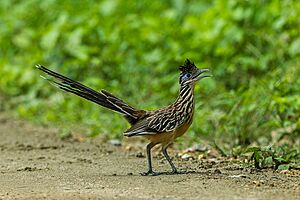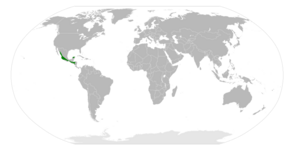Lesser roadrunner facts for kids
Quick facts for kids Lesser roadrunner |
|
|---|---|
 |
|
| Conservation status | |
| Scientific classification | |
| Genus: |
Geococcyx
|
| Species: |
velox
|
 |
|
| Range in green | |
The lesser roadrunner is a cool bird with long legs. It's part of the cuckoo family. You can find it in a region called Mesoamerica, which is in Central America. Its scientific name, Geococcyx velox, means "swift earth-cuckoo." This bird is one of two types of roadrunners, the other being the greater roadrunner.
Contents
What the Lesser Roadrunner Looks Like
The lesser roadrunner is a slim bird. It grows to be about 46 to 51 centimeters (18 inches) long. Its tail makes up a big part of that length, around 24 centimeters. Male roadrunners weigh between 174 and 207 grams. Females are a bit lighter, weighing 162 to 192 grams.
The top of its head, its feathery crest, and its neck are black. These parts have a shiny bronze look and small light brown spots. The back of its neck is dark brown. Its feathers have pale brown edges, making a cool striped pattern. The feathers on its upper body are dark brown with light speckles. Towards its bottom (rump), the color turns maroon. Its chest is white. The long tail feathers are black with a dark purple shine. Young roadrunners look like adults. But they have yellowish lines and duller skin around their eyes.
The roadrunner's eyes are yellow to brown. There's a yellow or silvery-white ring around the black center of its eye. The skin around its eye is light purple to bright blue. Behind the eye, a narrow red band goes towards its neck. This red part is usually hidden by feathers. The top part of its beak is gray, and the bottom part is bluish-gray.
The lesser roadrunner looks a lot like the greater roadrunner. But the lesser roadrunner is smaller. It has fewer stripes on its throat and chest. Its rump and outer wings are brownish, and its belly is yellowish. The lesser roadrunner also has a much shorter beak.
Where the Lesser Roadrunner Lives
The lesser roadrunner lives in dry, flat areas of Mesoamerica. It can be found up to 3,000 meters high. It likes open spaces with bushes and thorny plants. You can spot them in higher parts of volcanoes like Conchagua and San Miguel. They live in semi-open areas above the tree line there. They can also live in farms, like fields of henequen (a plant used for fiber) and corn.
They breed in southwestern Mexico. Their breeding area goes north into the western side of the Sierra Madre Occidental mountains. They also live in northern Central America. There's a separate group of them in the northern Yucatán Peninsula. In a small area, their home overlaps with the greater roadrunner's home. This happens in parts of Mexico like Sonora and Jalisco.
Roadrunner Behavior
The lesser roadrunner is super fast! It can run up to 20 miles per hour (about 32 kilometers per hour). It spends most of its time on the ground. It runs in open areas, along roads, or under bushes. It can fly a little bit, usually to perch on bushes or low trees.
In the early morning, roadrunners like to warm up in the sun. They might sit on a fence post or a bush. They lift their tail and drop their wings. Then they turn their back to the sun. They raise their shoulder feathers to show their black skin. This black skin helps them soak up the sun's heat. They also like to clean their feathers.
The roadrunner's call is a soft "cooing" sound. It makes about one note per second. It usually coos three to seven times, with the sound getting lower each time.
What the Lesser Roadrunner Eats
The lesser roadrunner eats many different things. It's an "opportunistic feeder," meaning it eats whatever it can find. Its diet includes seeds, fruit, small reptiles, and frogs. It often looks for large insects and small animals hit by cars along roadsides. Grasshoppers are a big part of its diet. It also eats many caterpillars.
Nesting and Eggs
Lesser roadrunners are known to breed in Mexico between April and July. In El Salvador, they breed in August.
The lesser roadrunner builds its nest in a low tree, a thorny bush, or an Opuntia cactus. The nest is usually about 2 meters (6.5 feet) off the ground. Their eggs are white and measure about 35 by 26 millimeters. A female usually lays 2 to 4 eggs at a time. Their nests are smaller than those of the greater roadrunner. But they are stronger and more tightly built. The nest is shaped like a cup. It's made from strong grass stems and twigs. It's about 14.5 centimeters (5.7 inches) across. Both male and female roadrunners take turns sitting on the eggs to keep them warm.
The number of eggs in a lesser roadrunner's nest doesn't change much. From what people have seen, all the eggs seem to hatch around the same time.
See also
 In Spanish: Correcaminos tropical para niños
In Spanish: Correcaminos tropical para niños


